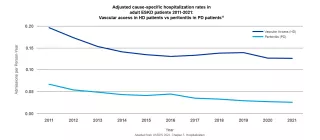
Preserve Vascular Access
Initiating Dialysis with PD preserves vascular access and eliminates the risk of HD access infections and complications1
Reduced access related infections & hospitalization rates for PD vs ICHD
Challenges of HD vascular access
- Infectious complications of vascular access are one of the major causes of morbidity and mortality in HD patients10
- HD vascular access is implicated as the source of bacteremia in 48-73% of patients with CVC as the highest source of infection11
- The use of CVCs has been clearly implicated in an increased risk of mortality and infection rates1
PD offers:
- Reduced risk of access complications, hospitalization and infection12,13,15,16
- The rate of hospitalization due to vascular access complications is higher than peritonitis-related hospitalization17
- Reduced number and risk of invasive interventions and associated complications12-16

Previous page
PD is the ideal bridge to kidney transplant associated with favorable post-transplant outcomes
Next Page
Peritonitis prevention strategies in PD
